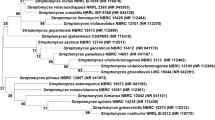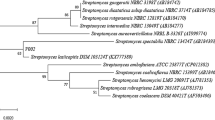Abstract
Two biologically active microbial strains were isolated from soil samples collected from different geographical areas of India. These strains were characterized as Streptomyces halstedii MTCC 6817 and Streptomyces anulatus MTCC 6818. Active compounds were extracted from the purified fermented broth and one of them was chemically characterized as actinomycin-D. Though these two strains produced the same antibiotic, their nutritional requirements vary substantially. For S. halstedii, a medium containing 1.5% fructose, 0.05% N-acetylglucosamine, and basal production medium, gave the maximum titre, 754% higher, as compared to production medium alone. In the case of Streptomyces anulatus, maximum antibiotic production was attained with a production medium containing 1.5% galactose and 0.05% L-asparagine monohydrate.


Similar content being viewed by others
References
Aharonowitz Y (1980) Nitrogen metabolite regulation of antibiotic biosynthesis. Ann Rev Microbiol 34:209–234
Aharonowitz Y, Demain AL (1978) Carbon catabolite regulation of cephalosporin production in Streptomyces clavuligerus. Antimicrob Agents Chemother 14:159–164
Cang S, Ohta S, Chiba H, Johdo O, Nomura H, Nagamatsu Y, Yoshimoto A (2001) New naphthyridinomycin-type antibiotics, aclidinomycins A and B, from Streptomyces halstedi. J Antibiot 54:304–307
Chatterjee S, Vining LC (1981) Nutrient utilization in actinomycetes. Induction of α-glucosidases in Streptomyces venezulae. Can J Microbiol 27:639–645
Cheng JR, Fang A, Demain AL (1995) Effect of amino acids on rapamycin biosynthesis in Streptomyces hygroscopicus. Appl Microbiol Biotechnol 43:1096–1098
Coisne S, Bechet M, Blondeau R (1999) Actinorhodin production by Streptomyces coelicolor A3(2) in iron restricted media. Lett Appl Microbiol 28:199–202
Doull JL, Vining LC (1990) Nutritional control of actinorhodin production of Streptomyces coelicolor A3(2); suppressive effect of nitrogen and phosphate. Appl Microbiol Biotechnol 32:449–454
Foster JW, Katz E (1981) Control of actinomycin D biosynthesis n Streptomyces parvullus: Regulation of tryptophan oxygenase activity. J Bacteriol 148:670–677
Gallo M, Katz E (1972) Regulation of secondary metabolite biosynthesis: catabolite repression of phenoxazinone synthase and actinomycin formation by glucose. J Bacteriol 109:659–667
Goss WA, Katz E (1956) Actinomycin formation by Streptomyces cultures. Appl Microbiol 5:95–102
Gebhardt K, Schimana J, Krastel P, Dettner K., Rheinheimer J, Zeeck A, Fiedler HP (2002) Endophenazines A-D, new phenazine antibiotics from the arthropod associated endosymbiont Streptomyces anulatus. I. Taxonomy, fermentation, isolation and biological activities. J Antibiot 55:794–800
Holmalahti J, Raatikainen AVW, Laatsch LH, Spohr A, Lyngberg OK, Neilsen J (1998) Production of dihydroabikoviromycin by Streptomyces anulatus: production parameters and chemical characterization of genotoxicity. J Appl Microbiol 85:61–68
Joo GJ (2005) Purification and characterization of an extracellular chitinase from the antifungal biocontrol agent Streptomyces halstedii. Biotechnol Lett 27:1483–1486
Katz E, Pienta P, Sivak A (1956) Role of nutrition in the synthesis of actinomycin. Appl Microbiol 6:236–241
Kim MY, Vankayalapati H, Shin-ya K, Wierzba K, Hurley LH (2002) Telomestatin, a potent telomerase inhibitor that interacts quite specifically with the human telomeric intramolecular G-quadruplex. J Am Chem Soc 124:2098–2099
Kimura KS, Kagami S, Ikeda Y, Takahashi H, Yoshihama M (1998) New types of liposidomycins that inhibit bacterial peptidoglycan synthesis and are produced Steptomyces. J Antibiot 51:640–646
Kurosawa K, Bui VP, VanEssendelft JL, Willis LB, Lessard PA, Ghiviriga I, Sambandan TG, Rha CK, Sinskey A (2006) Characterization of Streptomyces MITKK-103, a newly isolated actinomycin X2-producer. Appl Microbiol Biotechnol 72:145–154
Lebrihi A, Lamsaif D, Lefebvre G, Germain P (1992) Effect of ammonium salts ions on spiramycin biosynthesis in Streptomyces ambofaciens. Appl Microbiol Biotechnol 37:382–387
Lee MC, Kojima J, Demain AL (1997) Effect of nitrogen source on biosynthesis of rapamycin by Streptomyces hygroscopicus. J Ind Microbiol Biotechnol 19:83–86
Liu CM, McDaniel LE, Schafferer CP (1975) Factors affecting the production of candicidin. Antimicrob Agents Chemother 7:196–202
Martin JF, Demain AL (1980) Control of antibiotic biosynthesis. Microbiol Rev 44:230–251
Omura S, Tanaka J (1986) In: Regulation of Secondary Metabolites. VCH, Berlin. pp. 306–332
Parekh S, Vinci VA, Strobel K (2000). Improvement of microbial strains and fermentation processes. Appl Microbiol Biotechnol 54:287–301
Pereda A, Summers KG, Stassi DL, Ruan X, Katz L (1998) The loading domain of the erythromycin polyketide synthase is not essential for erythromycin biosynthesis in Saccahrpolyspora erythraea. Microbiology 144:543–553
Sanchez S, Demain AL (2002) Metabolic regulation of fermentation processes. Enz Microb Technol 31:895–906
Shindo K, Kamishohara M, Odagawa A, Matsuoka M, Kawai H (1993) Vicenistatin, a novel 20-membered macrocyclic lactam antitumor antibiotic. J Antibiot 46:1076–1081
Sousa MFVQ, Lopes CE, Pereira Jr N (2002) Development of a bioprocess for the production of actinomycin D. Braz J Chem Eng 19:277–285
Vinogradova KA, Kirilova NP, Sokolova ZG, Nikolau PA, Shalgina MV, Skvortsova GN, Polin AN (1985) Regulation of heliomycin biosynthesis by carbon sources. Antibiot Med Technol 30:264–270
Williams ST, Goodfellow M, Wellington EMH, Vickers JC, Alderson G, Sneath PHA, Sackin MJ, Mortimer AM (1983). A probability matrix for identification of some streptomycetes. J Gen Microbiol 129:1815–1830
Acknowledgements
We thank Mr. R. K. Purushottam (Scientist B-I) of S.A.I.F Division, C.D.R.I., for his help in HPLC analysis. This study was financially supported by the Council of Scientific and Industrial Research, India.
Author information
Authors and Affiliations
Corresponding author
Rights and permissions
About this article
Cite this article
Praveen, V., Tripathi, C.K.M. & Bihari, V. Studies on optimum fermentation conditions for actinomycin-D production by two new strains of Streptomyces spp.. Med Chem Res 17, 114–122 (2008). https://doi.org/10.1007/s00044-007-9042-7
Received:
Accepted:
Published:
Issue Date:
DOI: https://doi.org/10.1007/s00044-007-9042-7




